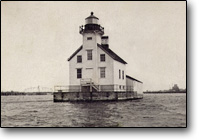 |
 |
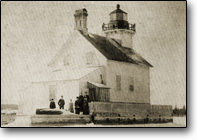 |
| Click thumbnails to view enlarged images | ||
| Dunlap Reef Range lights | Seeing The Light |
|
|
|
| Historical Information
Sturgeon Bay cut like a knife from Green Bay into Door County, virtually bisecting the Door peninsula almost to Lake Michigan. Native Americans and Voyageurs alike had long portaged their canoes between the two waterways, avoiding the circuitous route around the peninsula and through the treacherous Porte Des Morts passage at its northernmost end. 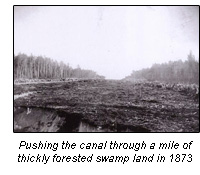 Construction
of the Sturgeon Bay Ship Canal was largely the result of one man,
Joseph Harris Sr., the editor of the Door County Advocate. Within a
short time of his 1855 arrival in Sturgeon Bay, Harris began writing of
the need to construct of a canal connecting Sturgeon Bay to Lake
Michigan through the sandy ridges east of town. Touting the long-term
economic impact of such a canal, Harris quickly garnered wide local
support for the project. Construction
of the Sturgeon Bay Ship Canal was largely the result of one man,
Joseph Harris Sr., the editor of the Door County Advocate. Within a
short time of his 1855 arrival in Sturgeon Bay, Harris began writing of
the need to construct of a canal connecting Sturgeon Bay to Lake
Michigan through the sandy ridges east of town. Touting the long-term
economic impact of such a canal, Harris quickly garnered wide local
support for the project.After it was determined that the costs associated with constructing the canal could be recouped through the collection of tolls from vessels using it, a group of local businessmen formed the "Sturgeon Bay and Lake Michigan Canal and Harbor Company," and began work on the 6,600 foot-long canal in July 1872. While the way was not open for the largest commercial vessels for a full ten years, small draft craft began using the canal as early as 1880. 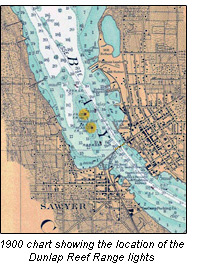 While
the majority of the canal was largely clear to navigation from bank to
bank, a long, thin, submerged 250-yard long limestone finger known as
locally as Middle Ground and officially as Dunlap Reef, lay just to the
northwest of the growing city of Sturgeon Bay and served as a real
threat to navigators making their way through the canal. After it was
proven too expensive to remove the reef, local interests began applying
pressure to Congress to fund the establishment of a light to warn of
the reef’s location. While the date and amount of the appropriation for
the lights has yet to have been identified, it is evident that
Congressional approval was obtained because Captain J. A. Bailey, 11th
District superintendent of lighthouse construction was reported to have
arrived Sturgeon Bay to located the sites for a pair of range lights to
mark the reef in mid May, 1881. While
the majority of the canal was largely clear to navigation from bank to
bank, a long, thin, submerged 250-yard long limestone finger known as
locally as Middle Ground and officially as Dunlap Reef, lay just to the
northwest of the growing city of Sturgeon Bay and served as a real
threat to navigators making their way through the canal. After it was
proven too expensive to remove the reef, local interests began applying
pressure to Congress to fund the establishment of a light to warn of
the reef’s location. While the date and amount of the appropriation for
the lights has yet to have been identified, it is evident that
Congressional approval was obtained because Captain J. A. Bailey, 11th
District superintendent of lighthouse construction was reported to have
arrived Sturgeon Bay to located the sites for a pair of range lights to
mark the reef in mid May, 1881.The following month, a crew of carpenters under the supervision of eleventh district construction foreman Charles Dobson were at work on shore in Sturgeon Bay building a pair of timber cribs to serve as foundations for the new structures. The first of these cribs was placed on August 1 and sunk in place by filling with locally quarried stone, and the second was completed by August 18. By early September, the Door County Advocate reported that exterior work on the two lighthouses was complete, and work was underway on their interiors.  The
front range structure took the form of an octagonal, pyramidal timber
frame tower sheathed with clapboards and surmounted by a small lantern
of iron and copper construction standing 14 feet in height. A small
service room was adjoined to the rear of the structure to provide
storage for oil and supplies, and to serve as shelter for the keeper
when he was working in the light. The
front range structure took the form of an octagonal, pyramidal timber
frame tower sheathed with clapboards and surmounted by a small lantern
of iron and copper construction standing 14 feet in height. A small
service room was adjoined to the rear of the structure to provide
storage for oil and supplies, and to serve as shelter for the keeper
when he was working in the light. The rear range lighthouse consisted of a one and a half story frame dwelling similarly sheathed with clapboard siding. A short square timber frame tower integrated into the roof at the north gable end and was capped with a standard prefabricated cast iron fourth order lantern. 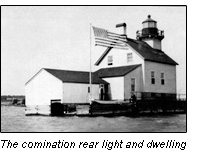 The
lighthouse tender DAHLIA arrived in Sturgeon Bay on October 5 to
deliver the lenses, lamps and oil for the lights, with a Fifth Order
Fresnel lens installed in the rear range tower at a focal plane of 39
feet, and a Sixth Order steamer lens in the front range at a focal
plane of 18 feet. Local resident Henry Graham was hired to serve
provisionally as keeper of the new lights on September 9, and he
officially exhibited the lights of the new Dunlap Reef range on the
night of Saturday October 15, 1881. The
lighthouse tender DAHLIA arrived in Sturgeon Bay on October 5 to
deliver the lenses, lamps and oil for the lights, with a Fifth Order
Fresnel lens installed in the rear range tower at a focal plane of 39
feet, and a Sixth Order steamer lens in the front range at a focal
plane of 18 feet. Local resident Henry Graham was hired to serve
provisionally as keeper of the new lights on September 9, and he
officially exhibited the lights of the new Dunlap Reef range on the
night of Saturday October 15, 1881.After keeper Graham complained about difficulty encountered in securing his boat at the rear range, in 1883 a crib 12 feet by 22 feet with a six-foot wide slip in its center and a surmounting boat house was erected to the rear of the lighthouse in which he could haul out his boat. Six years later in 1889, a construction crew from Detroit arrived to further enlarge this dock and enclosed it with with a boat house into which the keeper could safely store the station boat out of the weather. It also provided much needed storage space for wood for the stoves which served to heat the dwelling durng the winter months. In order to help them to stand out against the increasing number of lights in the city on both sides of the bay, the lights in both the front and rear range were changed from white to red in 1907. 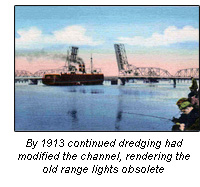 As
a result of ongoing channel improvements and changes in the vessel
track, plans were in place in 1913 to erect a new range consisting of a
pair of economical short skeletal iron towers with automatic acetylene
illumination systems with one such light on the northwest end of Dunlap
Reef and the other at Hills Point, thereby replacing the old range line
and rendering its associated structures obsolete. While these
improvements took a few years to reach fruition, the die was cast and
the Dunlap Reef Range lights were not relighted at the opening of the
1924 navigation season after 42 years of service. As
a result of ongoing channel improvements and changes in the vessel
track, plans were in place in 1913 to erect a new range consisting of a
pair of economical short skeletal iron towers with automatic acetylene
illumination systems with one such light on the northwest end of Dunlap
Reef and the other at Hills Point, thereby replacing the old range line
and rendering its associated structures obsolete. While these
improvements took a few years to reach fruition, the die was cast and
the Dunlap Reef Range lights were not relighted at the opening of the
1924 navigation season after 42 years of service.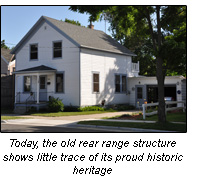 No
longer necessary and of potential use elsewhere in the system, the
lantern on the old rear range structure was removed and the
illumination equipment recovered from both the old structures and
shipped to the Twelfth District depot in Milwaukee for storage. The
front range structure was then demolished and the rear range dwelling
offered for sale at public auction in 1925. Sturgeon Bay resident Ruben
Dickinson’s bid of $226 was the highest received, and according to the
terms of the purchase, he dismantled the house and transported it
across the ice into Sturgeon Bay where he re-erected it a 411 S. 4th
Avenue. No
longer necessary and of potential use elsewhere in the system, the
lantern on the old rear range structure was removed and the
illumination equipment recovered from both the old structures and
shipped to the Twelfth District depot in Milwaukee for storage. The
front range structure was then demolished and the rear range dwelling
offered for sale at public auction in 1925. Sturgeon Bay resident Ruben
Dickinson’s bid of $226 was the highest received, and according to the
terms of the purchase, he dismantled the house and transported it
across the ice into Sturgeon Bay where he re-erected it a 411 S. 4th
Avenue.This dwelling on a quiet tree-lined back street in downtown Sturgeon Bay is the only remnant of what was once a vital aid to navigation, and it is likely that most who pass the house have no idea of its historic heritage.
Click Here to see a complete listing
of all Dunlao Reef Range light keepers compiled by Phyllis L.
Tag of Great Lakes Lighthouse Research.
Seeing
this Light Unfortunately all traces of the
original Dunlap Reef Range lights have been competely obliterated. The
building which used to serve as the rear range light can be seen
at 411
S. 4th Avenue in Sturgeon Bay. Since the building is now a private
residence on a residential street, kindly respect the privacy
of the residents in the area if you decide to photograph
the building. GPS Coordinates: 44°49'53.31"N x 87°22'19.65"W Historical Resources Door County Advocate newspaper articles, various |